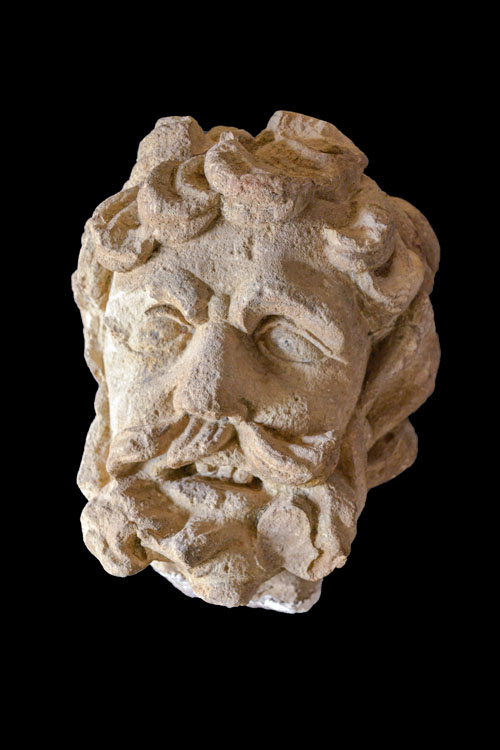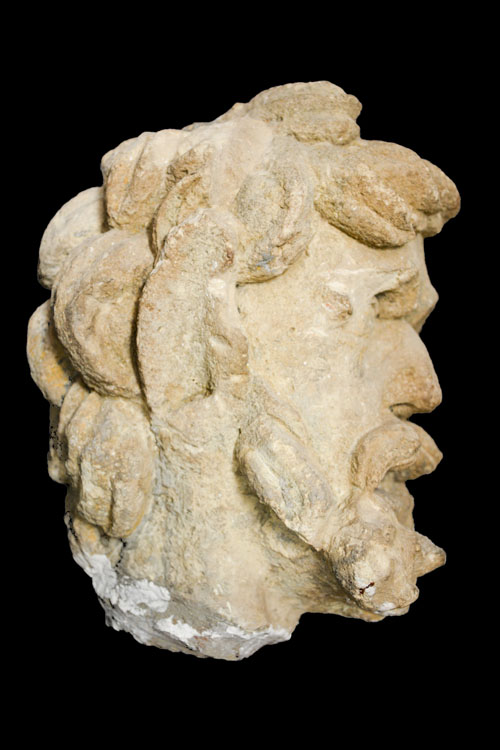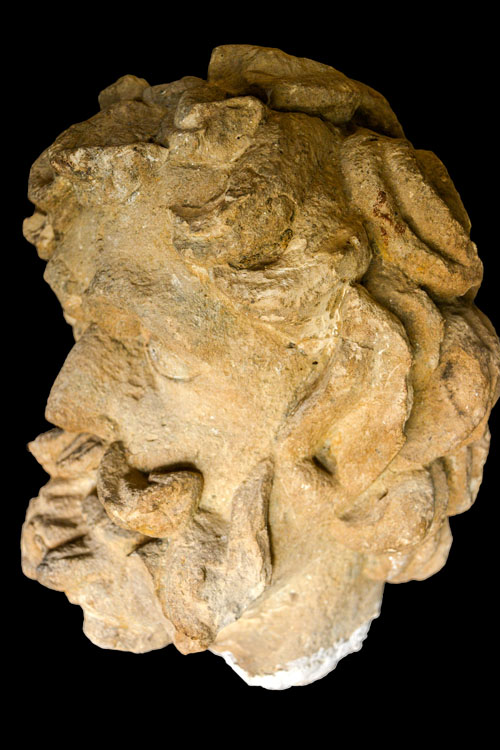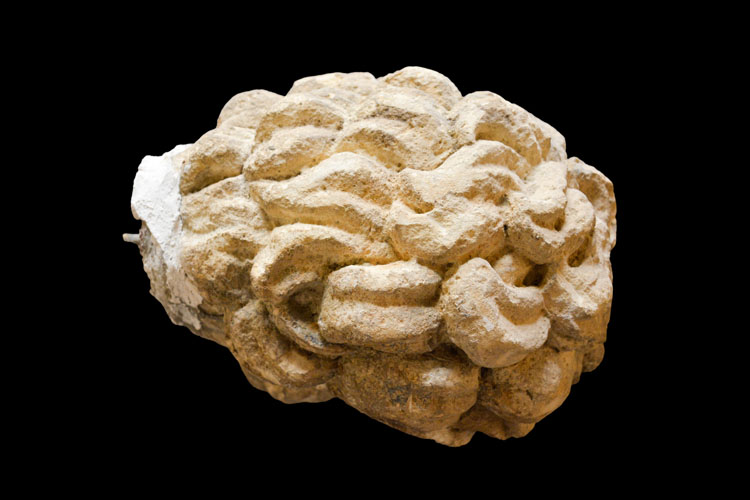Limestone head of Satyr, or Centaur
Category
Gozo GroupAbout This Artefact
I.D. no: 100895
Dimensions: H. 33 cm; W. 25 cm
Material: Somewhat friable limestone
Provenance: unknown[1]
Current location: Gozo Museum of Archaeology
Condition: Head is broken at the lower neck. Chips are visible on the right eyebrow and here and there on the hair and beard. A hazelnut-coloured patina covers most surfaces while traces of dark brown paint survive on the right ear.
Description: The bearded head with large pointed ears belongs to an hirsute creature, a satyr or, more probably, a centaur. Its big eyes, with their incised pupils, slope down at the outer extremities. Heavy eyebrows project over the deep-set eyes with a schematic circular swelling over the nose. The nose is big, the mouth open showing three upper teeth deep inside. The moustache is formed of three separate tufts, two directed sideways under the cheeks, while the middle one overlaps the mouth asymmetrically to its right. The beard and hair are formed of thick semicircular locks pointing haphazardly in different directions. The expression of anger imparted by the open mouth and bared irregular teeth, as well as the wide-open eyes, accentuate the wild nature of the figure. The impressionistic rendering of the hair and facial features make an overall pleasant, even if rugged, piece of work.
Discussion: There exist several similarly expressive and hirsute heads with pointed caprine (or equine) ears with which this Gozo head can be compared. Some have been identified as Silenus[2] or Satyr[3] but in the majority of cases they are correctly attributed to centaurs.[4] Of these comparanda, the head from Delos is clean-shaven and has grown a pair of short horns which probably justify its identification as a satyr,[5] but stylistically, in its summary and impressionistic treatment, and in the expression imparted by the open mouth, which exposes a menacing set of teeth, it has much more in common with the Gozo head. The marble head from Cordoba,[6] on the other hand, falls undoubtedly within the range of bearded, hornless, pointed-eared heads with tormented facial features, which fit much better the ferine character of centaurs than the sensual grins of Silenus or satyrs. The expression on the centaur’s head from Virunum is pathetic, almost paternal and affectionate, rather than fierce; an expression that is further enhanced by the backward turn of the head.[7]
The confirmation of the identification of the Gozo head as a centaur comes from a group of four statuettes representing centaurs from Oplontis.[8] The heads of two of them, the male ones, bear a strong resemblance, both iconographically and stylistically, to our head; they are paralleled by three similar statuettes previously in the Somzée collection in Brussels.[9]
There is no doubt that this head was inspired by some as yet unidentified Hellenistic original in the Baroque fashion, but it was carved locally, probably by a local artist, perhaps the same sculptor who carved the other Gozitan piece of sculpture in local limestone, the lost telamon from the Roman villa of Ramla Bay since they share common iconographic and stylistic features. It finds some similarity in a colossal head of a ‘prisoner’ – he has a ring round his neck, attached to a chain – in limestone kept on site in the Ginnasio Romano in Syracuse.[10] He wears a similar, albeit smaller moustache and his mouth is open in a similar fashion, showing the upper teeth. This similarity suggests some influence from Sicily on Maltese vernacular art or a common sculptural idiom shared by both islands.
Date: Neither the coarse style nor the summary technique of the carving are easy to date; a tentative date for the source of inspiration in the late Hellenistic age, in the aftermath of the Greek Baroque, is suggested.
Bibliography: (previous publications of item):
Bonanno 1992: 33 (satyr, local work). Bonanno 2005: 348-49 (satyr).
[1] The life-size head of a satyr (or, it seems more probable, a centaur) with pointed ears is said to have stood, for a period of time, on a wall of a farmhouse in the immediate vicinity of ‘Calyso’s cave’, overlooking Ramla bay and, as such, could have easily originated from the Roman villa in that same bay. It should be recalled that a telamon in local stone of a figure with pointed ears (most probably a satyr) was discovered during the excavation of the same villa in 1910-1911 (Ashby 1915: 72, fig. 29) and soon after disappeared.
[2] García y Bellido 1949: 101, no. 90, pl. 76.
[3] Marcadé 1969: 205, no. A4290, pl. 27.
[4] Such as the centaur from Virunum (Noll 1949: 15, pl. 7-8; Piccottini 1968: 38, no. 61, pl. 44) and the one from Chieti (Cianfarani 1971: inv. No. 5591).
[5] Marcadé 1969 (note 2).
[6] García y Bellido 1949 (note 1).
[7] Piccottini 1968 (note 3), certainly belonging to a copy of the Old Centaur with Eros on his back, a Hellenistic work signed by Asteas and Papias (Bieber 1961: 140-41, figs 581, 583).
[8] De Caro 1976: 184-225, figs 5-20.
[9] Reinach 1897: 823, nos 1-3; De Caro 1976 (note 8): figs 22-27.
[10] I have not yet a citation for the Syracuse head which I photographed decades ago.




